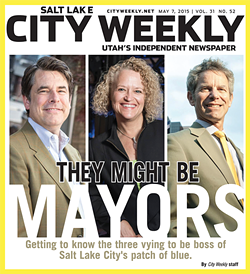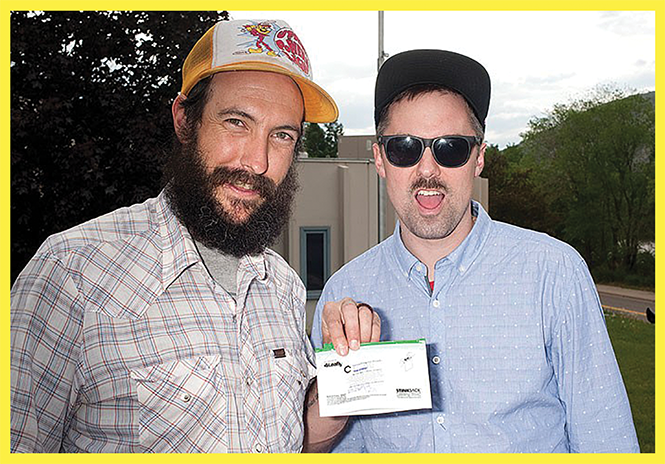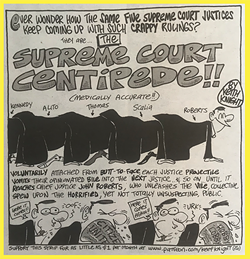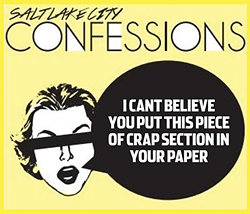"It was New Year's Eve when I received a call from John Saltas, City Weekly's founder and publisher," Jerre Wroble wrote for an editorial on March 5, 2015. "There was already some bubbly in my glass, so I let it go to voicemail. Not only was I marking the end of 2014, I was also toasting to my imminent departure from Utah." Curiosity eventually won out, however, and Wroble listened to Saltas' message. It informed her that editor Rachel Piper would be departing and someone would need to fill the void until arrangements could be made.
"I told him I'd already put down a deposit on a rental in Oregon, the moving van was coming later that week, and I'd even packed a few boxes," Wroble related. "But I felt torn. For one thing, John Saltas—someone I can barely say 'no' to—was asking. For another, I could feel my inner pilot-light igniting. Could it be? After leaving City Weekly in 2013, literally to take a break, would I get another chance to do this journalism dance?"
By the end of the 31st production cycle, Wroble was leading the dance as Interim Editor, with Brandon Burt, Bill Frost, Kolbie Stonehocker and Scott Renshaw all providing additional support and leadership.
Rents were going up, affordable housing was scarce and Salt Lake City was named the 7th most polluted city in the nation by the American Lung Association. Yes, life was strained in the Beehive State, as heavy doses of apathy kept voters away from civic meetings and elections. It likely didn't help that public processes were either being sidelined or ignored entirely—such was the case with the relocation of the Draper prison and the endless crusade to unlock public federal lands for private exploitation.
Law enforcement was under scrutiny after the deaths of Michael Brown in Ferguson, Missouri, and Freddie Gray in Baltimore, Maryland. Closer to home, Utahns were outraged at the dismissal of a manslaughter case against former West Valley police officer Shaun Cowley for shooting Danielle Willard, to say nothing of the fatal police shootings of Darrien Hunt in Saratoga Springs and Geist the dog in Salt Lake City. The shooting of alleged Tongan Crips gang member Siale Angilau—who rushed the witness stand with a pen during trial—sparked a vigorous Pacific Islander youth movement called Raise Your Pen against heavy-handed policing methods.
Other moves in the year's promenade were far more satisfying. A Utah program called Housing First received acclaim for providing housing to the chronically homeless without requiring sobriety, significantly decreasing unsheltered rates. And the compromise bill SB296 added sexual orientation and gender identity as protected classes in employment and housing.
Eric Peterson's series on convicted murderers Ron and Dan Lafferty was gripping, while Robyn Van Valkenburg's cover story on Utah's inmate horse-gentling program was graceful. Courtney Tanner's profile on heart transplant hopefuls moved the reader while Colby Frazier and Colin Wolf's journey to Colorado for legalized marijuana amused.
It was this year City Weekly acquired the skills of copy editor Tiffany Frandsen and intern Sam Florence, when Mike Riedel began writing on beer and Christa Zaro covered local shopping. Derek Carlisle became art director after the departure of Susan Kruithof, with Mason Rodrickc handling production. Added to the presence of CW veterans, we could take comfort in knowing that despite all the shifts in public tempo, City Weekly could still get into the groove.
Remembering Vol. 31: In syndication
While most of our pages have featured writers specific to City Weekly's masthead, we would be a poor alternative paper—and an ungrateful one—if we overlooked the syndicated content that has been a part of our package since the late 1980s. CW has been fortunate to host the editorial creations of such cartoonists as Evan Twede, John de Rosier, Jonathan Brown, and Mark Pett as well as the satire of local humorists like D.P. Sorensen—whose Deep End column was often mistaken for being real news—but also the shared content so characteristic of the counterculture scene.
Chuck Shepherd's "News of the Weird'' and Roland S. Sweet's (1945-2015) "News Quirks'' amused readers. Gustavo Arellano's "Ask a Mexican" was another favorite, as were the Q&As found in "The Straight Dope" by the pseudonymous Cecil Adams. Don Rubin's (1945-2022) "Real Puzzle" brain-teasers and David Levinson Wilk's crosswords challenged, Barry Friedman's satire column was good for either a laugh or a gasp, and Rob Brezsny offers guidance to this day with his "Free Will Astrology."
And then there have been the comics, like Matt Groening’s “Life in Hell,” “Ernie Pook’s Comeek” by Lynda Barry, “The K Chronicles” by Keith Knight, the doodles of Pete S. Mueller and the work of Caryn Leschen. We have featured Jen Sorensen’s self-titled comic strip, Ruben Bolling’s (aka Ken Fisher’s) “Tom the Dancing Bug,” Bill Griffith’s “Zippy the Pinhead,” Derf (aka John) Backderf’s “The City,” Max Cannon’s “Red Meat” and, of course, the ubiquitous “Modern World” by Tom Tomorrow (aka Dan Perkins).
"These were things otherwise unseen in Salt Lake City," John Saltas recalls. "Over the years, we did tons of stuff that no one was doing, attracting readers [outside of] the traditional news pages ... And each brought readers that then sought out other parts of the paper."
On the shelves
"On Dec. 19, 2014, Jessica Ripley finally got an answer to a question she'd been asking since she was sexually assaulted by a man she'd danced with at a downtown Salt Lake City nightclub in February 2012," began Stephen Dark's report. Ripley's story of not being believed by officers and of trying to locate the rape kit she gave hospital examiners had already been reported as a January 2014 cover feature, but within the Jan. 1, 2015, issue Dark could at last provide some developments to the saga.
In August 2014, Dark wrote, Ripley emailed the Salt Lake City Police Department (SLCPD) seeking information on her case. Her meeting four months later with Sgt. Lisa Pascadlo—then-executive officer to Chief Chris Burbank—was, besides the initial interview, the "first time" she met with anyone in person about her case. Although the DNA from Ripley's rapist had been uploaded to the national Combined DNA Index System immediately after she provided a hospital nurse her rape kit, there remained many unknowns.
Utilizing data from a study by BYU professor and nurse Julie Valentine, Dark had previously reported that a vast majority of rape cases within Salt Lake County were not being addressed. "Cops rarely believed victims, few cases were screened with prosecutors, and those that were usually ended up being declined," Dark summarized. "In addition, most rape kits idled on shelves in police departments rather than being submitted to the state crime lab for testing."
Since January 2014, however, SLCPD had commenced a project at the City Council's urging that dedicated four detectives to review the nearly 700 unprocessed rape kits within their walls and to reevaluate best practices with aid from the Department of Justice. Finally discovering what happened to her rape kit, Ripley remained confused why it had taken so long to get answers.
"It's kind of strange they had it the whole time and are now just giving it to me," Ripley told Dark. Emailing Pascadlo about the delay, Dark was informed that "there is no policy requiring notification to a victim."
With her assailant's DNA accessible to other police departments, Ripley told Dark of feeling relieved beyond description. "I can't even explain what comfort it brings to me," she said. "I feel like a little bit of justice has been served on my part."
Appearing on various media outlets about her experience and inspiring others to come forward about their own sexual assaults, Ripley had but one message for those out there similarly affected. "It's been the shittiest experience I've ever gone through," she said. "But if you don't report it, you're letting that person win."
In secret
One notable feature that appeared near the back of print issues during this time was the "Confessions" box, wherein readers could anonymously confess their secrets. From the bizarre and questionable to the innocuous and even charming, the entries made for a fascinating window into the many lives around Salt Lake City.
—"Some friends and I took a road trip down to BYU to play devil's advocate and trick some students into drinking. Turns out they knew exactly what they were drinking and drank us under the table. Touche BYU, touche."
—"I have been going around stores putting stuff in people's bags and then telling store security that I saw the person putting the item in the bag. It's really good free entertainment."
—"I broke up my dad and stepmom because I wanted to hook up with her. Well, my brother did instead. All that work and no reward. My life sucks."
—"I swapped my pee sample with someone ... at a drug screening for work cause I smoked some weed. Apparently, he had smoked angel dust. I was fired, he got to keep the job after entering counseling. Talk about instant karma."
More by Wes Long
-
40 Years of City Weekly—Volume 36: 2019 to 2020
City Weekly Rewind
- Apr 24, 2024
-
40 Years of City Weekly—Volume 35: 2018 to 2019
City Weekly Rewind
- Apr 17, 2024
-
Salt Lake's modern tree canopy is a living legacy of the peoples of Utah.
Life in the Slow Lane
- Apr 17, 2024
- More »









